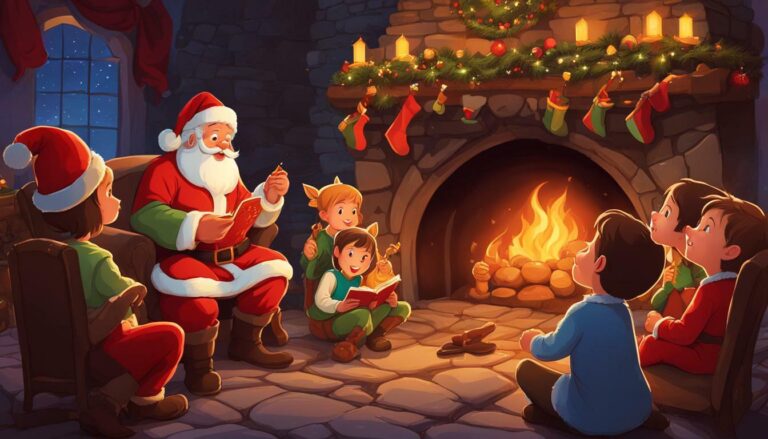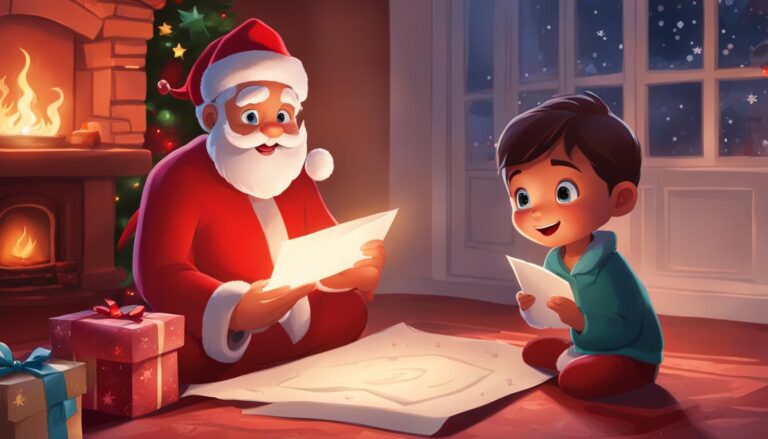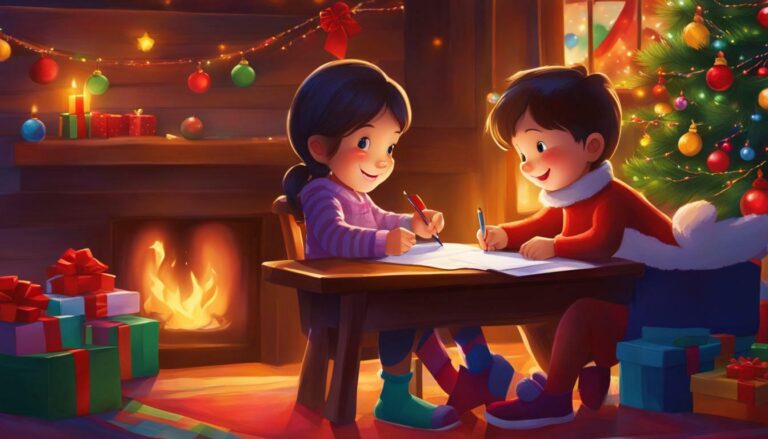From the Desk of Santa Claus: Jolly Messages & Stories

Welcome to the enchanting world of Santa Claus! Have you ever wondered what goes on at Santa’s desk? It’s a place filled with magic, joy, and heartwarming stories. From the desk of Santa Claus, countless letters from children around the world arrive, carrying their hopes, dreams, and innocent wishes.
Throughout history, newspapers have collected and published these precious letters, giving us all a glimpse into the excitement and innocence of the holiday season. Kind individuals, acting as Santa Claus, have even taken the time to answer some of these heartfelt messages.
Key Takeaways:
- Letters to Santa Claus hold a magical power, capturing the hopes and dreams of children.
- The tradition of writing letters to Santa Claus dates back to the late 1800s and early 1900s.
- Notable personalities, such as Shirley Temple, have also written letters to Santa Claus.
- The image of Santa Claus developed throughout the 19th century, influenced by famous illustrations and poems.
- The postal service has played a significant role in delivering letters to Santa Claus since the late 1800s.
Letters Sent to Santa Claus from Various Locations
Letters addressed to Santa Claus have been sent from various locations, each with its own touch of imagination and wonder. Children from all over the world have written heartfelt letters to Santa, using stationery adorned with holiday icons and their own creative designs. These letters, filled with innocence and excitement, provide a glimpse into the wishes and dreams of children from different regions.
Imaginative addresses like Snow Land, North Land, and Ice Land added a touch of magic to the letters. Kids would pour their hearts into these messages, expressing their desires for the holiday season. These heartfelt letters were collected by newspapers, creating an archive of dreams and hopes that captured the spirit of Christmas during the late 1800s and early 1900s.
The tradition of writing letters to Santa Claus has continued over the years, preserving the excitement and innocence that comes with expressing holiday wishes. While the locations may have changed, the joy of putting pen to paper and sending off a letter filled with dreams remains a cherished part of the holiday season.
Table: Various Locations from Where Letters Were Sent to Santa Claus
| Location | Year |
|---|---|
| Snow Land | 1890 |
| North Land | 1905 |
| Ice Land | 1912 |
| Starville | 1925 |
| Toy Town | 1938 |
These letters remind us of the magic and wonder that children experience during the holiday season. They bring us back to a time of innocence and belief, when all dreams seemed possible and the anticipation of Santa’s arrival was palpable. The tradition of sending letters to Santa Claus from various locations serves as a heartwarming reminder of the joy and excitement that envelops the holiday season.
Famous Personalities Writing to Santa Claus
Even famous personalities couldn’t resist the enchantment of writing letters to Santa Claus. One notable figure who expressed her holiday wishes to Santa was Shirley Temple. In her heartfelt letter, the beloved child star asked Santa to grant all the boys and girls the best Christmas ever. This delightful correspondence from famous individuals adds an extra touch of magic and joy to the holiday season, reminding us that even celebrities have their own childhood dreams and wishes.
“Dear Santa Claus, I hope you will bring me lots of Christmas presents and a pretty new doll. But most of all, I hope you will give all the boys and girls the best Christmas ever. Your little friend, Shirley Temple.”
These letters from famous personalities become treasured pieces of history, showcasing the universal joy and wonder that Santa Claus brings to people of all backgrounds. They remind us that no matter who we are, the Christmas spirit unites us all in our hopes for love, happiness, and goodwill.
In the next section, we will delve into the development of the iconic Santa Claus image and how it has evolved over time.
The Development of the Santa Claus Image
The image of Santa Claus as we know him today developed throughout the 19th century. It started with the publication of the famous poem “A Visit From St. Nicholas” (also known as “The Night Before Christmas”) in 1823. The poem, written by Clement Clarke Moore, introduced the cheerful and generous Santa Claus who delivers gifts on Christmas Eve.
However, it was the illustrations by cartoonist Thomas Nast in Harper’s Weekly that truly shaped the visual representation of Santa Claus. Nast’s drawings, which began in the 1860s, depicted Santa Claus as a jolly man with a round belly, rosy cheeks, and a white beard. He portrayed Santa Claus at his desk, reading letters from children and making notes on his list.
“Thomas Nast’s illustrations of Santa Claus helped create the visual references for Santa Claus that are still familiar today.”
Nast’s illustrations were instrumental in popularizing this image of Santa Claus, and his depiction became widely adopted. The inclusion of Santa Claus at his desk, reading letters from children, added to the mystique and magic surrounding the figure. Today, the image of Santa Claus at his office is recognized worldwide and remains a beloved part of the Christmas tradition.
| Year | Event |
|---|---|
| 1823 | Publication of “A Visit From St. Nicholas” introduces the modern Santa Claus character. |
| 1860s | Cartoonist Thomas Nast’s illustrations of Santa Claus in Harper’s Weekly popularize the image of Santa at his desk. |
The Role of the Postal Service in Letters to Santa
The involvement of the postal service in letters to Santa Claus is an integral part of the holiday season. In the late 1800s, letters addressed to Santa were initially considered undeliverable and often returned or sent to the Dead Letter Office. However, philanthropic individuals and charities recognized the opportunity to bring joy to children in need. In 1911, an order was issued allowing letters addressed to “Santa Claus” to be delivered to responsible institutions or individuals for philanthropic purposes.
This practice continues to this day, with the United States Postal Service (USPS) playing a significant role in the delivery of letters to Santa. Each year, children from all over the country write heartfelt letters to Santa Claus, expressing their wishes and dreams for the holiday season. These letters are then sent to designated post offices, where they are carefully sorted and processed.
Through the USPS’s Operation Santa program, volunteers can adopt letters from children in need and fulfill their holiday wishes. This heartwarming initiative allows individuals and organizations to act as Santa’s helpers, spreading cheer and making dreams come true for children who may otherwise go without. By participating in Operation Santa, you can be a part of the magic by granting wishes and bringing joy to young hearts.
Operation Santa: How It Works
Operation Santa is an annual program run by the USPS that allows individuals and organizations to become Santa’s helpers. Here’s how it works:
- Starting in December, participating post offices across the country display letters to Santa in designated areas.
- Volunteers can visit these post offices, read the letters, and choose which ones they would like to fulfill.
- Once a letter is adopted, the volunteer purchases the requested gifts and returns them to the post office.
- The USPS then ensures that the gifts are delivered to the children, bringing happiness and holiday magic to their lives.
By participating in Operation Santa, you not only make a child’s Christmas special but also experience the joy of giving and the true spirit of the holiday season.
| Benefits of Operation Santa | How to Get Involved |
|---|---|
|
|
Funny Santa Jokes
Add a touch of laughter to your holiday season with these funny Santa jokes. Whether you’re sharing them at a Christmas party or including them in your Christmas cards, these jokes are sure to bring joy to both kids and adults alike.
Why does Santa go down the chimney?
Because it soots him!
What do you call Santa when he takes a break?
Santa Pause!
Looking for more laughs? Check out these cute and kid-friendly Santa jokes:
- Why did Santa go to music school?
- Because he wanted to improve his “wrap” skills!
- What do you call Santa when he loses his pants?
- St. Knickerless!
Spread the holiday cheer with these funny Santa jokes and make this Christmas season a jolly and memorable one!
| Joke | Punchline |
|---|---|
| Why did Santa go to the doctor? | Because he had low “elf” esteem! |
| What’s Santa’s favorite type of music? | Wrap music! |
| What do you get if you cross Santa with a detective? | Santa Clues! |
Hilarious Jokes About Santa Claus and Christmas
Get ready for a good laugh with these hilarious jokes about Santa Claus and Christmas. These jokes are guaranteed to bring a smile to your face and brighten up your holiday season. Whether you’re sharing them with family, friends, or coworkers, these jokes will create a joyful atmosphere and spread the festive cheer.
“Why did Santa go to music school? Because he wanted to improve his “wrap” skills!”
Have you heard the one about Santa’s reindeer playing musical instruments? It’s no surprise that they’re all great in their respective “rein” of talent! These jokes are perfect for kids and adults alike, making them a fun addition to holiday parties, gift exchanges, or even just to brighten up someone’s day.
So, gather around the Christmas tree and let the laughter begin with these funny Santa jokes:
- What do you call Santa when he takes a break? Santa Pause!
- Why did Santa’s helper see the doctor? Because he had low “elf” esteem!
- How does Santa keep his suits wrinkle-free? He uses Claus-tarch!
Remember, the holiday season is all about spreading joy and laughter. These jokes are sure to make everyone’s spirits bright and keep the holiday festivities merry and bright!
| Joke | Punchline |
|---|---|
| Why did Santa go to music school? | Because he wanted to improve his “wrap” skills! |
| What do you call Santa when he takes a break? | Santa Pause! |
| Why did Santa’s helper see the doctor? | Because he had low “elf” esteem! |
| How does Santa keep his suits wrinkle-free? | He uses Claus-tarch! |
Santa Jokes for Kids
Looking to add some festive cheer and laughter to your holiday celebrations? We’ve got you covered with these cute and funny Santa jokes that are perfect for kids. Share them with your little ones and watch their faces light up with laughter. These jokes are guaranteed to bring joy and merriment to the holiday season.
1. Why did Santa go to music school? Because he wanted to improve his “wrap” skills!
2. What do you get if you cross Santa with a detective? Santa Clues!
3. What do you call Santa when he loses his pants? Saint Knickerless!
4. Why did Santa’s helper see the doctor? Because he had low “elf” esteem!
These kid-friendly jokes are sure to bring smiles and giggles to your little ones. Share them during family gatherings, parties, or around the dinner table. Create joyful memories and spread the holiday cheer with these adorable Santa jokes.
| Joke | Punchline |
|---|---|
| 1 | Why did Santa go to music school? Because he wanted to improve his “wrap” skills! |
| 2 | What do you get if you cross Santa with a detective? Santa Clues! |
| 3 | What do you call Santa when he loses his pants? Saint Knickerless! |
| 4 | Why did Santa’s helper see the doctor? Because he had low “elf” esteem! |
Share these jokes with your kids and see their faces light up with laughter. These cute and funny Santa jokes are perfect for spreading holiday cheer and creating a festive atmosphere. Enjoy the magic and joy of the season with these delightful jokes!
The History of Letters to Santa
The tradition of writing letters to Santa Claus dates back to the early 19th century. Initially, these letters were written by parents on behalf of Santa to encourage good behavior in children. Over time, the practice evolved, and children began writing their own letters to Santa, expressing their wishes and dreams for the holiday season. The postal service’s involvement in delivering these letters further solidified the tradition, making it a beloved part of Christmas celebrations.
Letters to Santa Claus hold a special place in the hearts of children around the world. They eagerly take out their favorite stationery, carefully craft their messages, and address them to the North Pole. These heartfelt letters are filled with excitement, hopes, and dreams, creating a bridge between the real and the magical. They are a way for children to express their deepest desires and believe in the enchantment of Christmas.
The mailboxes of the Santa Claus Postal Service overflow with these precious letters every year. From snowy landscapes to twinkling lights, children pour their imagination onto paper, sharing their wishes for toys, books, and even moments of joy. The joy of receiving a response from Santa Claus only adds to the magic of the season, reinforcing the belief that dreams can come true.
The Art of Letter Writing
Writing a letter to Santa Claus is an art form in itself. Children carefully select the perfect stationery, adorned with festive designs. They meticulously craft their messages, ensuring they capture the essence of their desires. These letters carry a sense of innocence and wonder, reflecting the purity of a child’s heart. They remind us of the power of imagination and the joy that can be found in the simplest of things.
The tradition of writing letters to Santa Claus is a cherished one, passed down through generations. It serves as a reminder of the importance of belief, hope, and the magic of the holiday season. As long as there are children with dreams in their hearts, the tradition of letters to Santa will continue to bring joy and wonder to homes around the world.
The Impact of Santa Letters
Letters to Santa Claus have a profound impact on both children and those who receive and respond to them. For the children, writing a letter to Santa is a heartfelt expression of their hopes and dreams, a tangible connection to the magic of Christmas. It gives them a sense of excitement and anticipation as they share their wishes and wait for a reply from the jolly old man himself.
But the impact goes beyond the children who write the letters. For those who have the privilege of answering these letters, whether as volunteers, parents, or charitable organizations, it is an opportunity to bring joy and happiness into children’s lives. It allows them to play a part in creating cherished memories and make a child’s Christmas dreams come true. The act of responding to these letters reinforces the belief in the magic of Santa Claus and the spirit of giving, both for the recipient of the letter and the person who takes the time to write a personalized response.
The tradition of Santa letters not only creates a special bond between children and Santa Claus but also fosters a sense of community. It brings people together, reminding us all of the importance of generosity, kindness, and the joy of giving during the holiday season. Whether it’s through a formal program or a personal exchange, the impact of Santa letters extends far beyond the paper they are written on, spreading love and holiday cheer to all involved.
Continuing the Tradition of Santa Letters
If you want to keep the magic of Christmas alive, encourage your child to write a heartfelt letter to Santa Claus. Sitting at their own little desk, with festive stationary and a pen in hand, they can pour out their wishes and dreams. The act of writing to Santa Claus has been a beloved tradition for generations, and it’s a tradition worth continuing.
Writing a letter to Santa not only allows your child to express their desires but also encourages the belief in the magic of the holiday season. As they put their words on paper, they immerse themselves in the joy and wonder that Santa Claus represents. It’s a beautiful way for your child to experience the anticipation and excitement leading up to Christmas Day.
Whether they ask for toys, share their hopes for a white Christmas, or express gratitude for the blessings in their lives, Santa’s mailbox is always open for them. And the joy doesn’t stop there. When your child receives a response from Santa Claus, their faces light up with delight and wonder. It’s a precious moment that will create cherished memories for years to come.
So, make sure to keep this tradition alive. Set up a little desk for your child, complete with special Santa Claus stationery. Encourage their creativity and imagination as they write their letter, and send it off in the mail. Santa Claus is eagerly waiting to hear from them, ready to fulfill their dreams and make their holiday season merry and bright.
FAQ
What is the history behind writing letters to Santa Claus?
The tradition of writing letters to Santa Claus dates back to the early 19th century. Initially, parents would write these letters on behalf of Santa to encourage good behavior in children. Over time, children began writing their own letters to Santa, expressing their wishes and dreams for the holiday season.
How did letters to Santa Claus become popularized?
In the late 1800s and early-to-mid 1900s, letters to Santa were collected and published by newspapers across the United States. Some of these letters were even answered by kind individuals acting as Santa Claus. Notable individuals, such as Shirley Temple, have also written letters to Santa Claus, adding a touch of magic and joy to the holiday season.
What role did the postal service play in delivering letters to Santa Claus?
The involvement of the postal service in letters to Santa Claus began in the late 1800s. Initially, these letters were considered undeliverable and either returned or sent to the Dead Letter Office. However, philanthropists and charities saw an opportunity to fulfill the role of Santa for children in need. Today, the USPS even offers a program for parents to reply to their children’s letters to Santa.
Are there any funny Santa jokes to enjoy during the holiday season?
Absolutely! ‘Tis the season to laugh with funny Santa jokes that bring joy to both kids and adults. From puns about Santa’s little elves to one-liners about Santa’s antics, these jokes are perfect for sharing during holiday gatherings or including in Christmas cards. They provide a lighthearted and humorous way to celebrate the magic and merriment of the season.
What is the impact of Santa letters on children and those who receive and respond to them?
Letters to Santa Claus have a profound impact on both children and those who receive and respond to them. For children, it is a way to express their hopes and dreams and a reminder to believe in the magic of Christmas. For those who answer these letters, it is an opportunity to bring joy and happiness to children’s lives. The tradition of Santa letters continues to inspire and create cherished memories during the holiday season.
Is the tradition of writing letters to Santa Claus still alive today?
Yes, the tradition of writing letters to Santa Claus continues, with children around the world eagerly penning their wishes and dreams. Whether they send their letters through traditional mail or use online platforms, the joy and excitement of receiving a response from Santa Claus remain the same. Parents, schools, and charitable organizations often play a role in keeping this cherished tradition alive, ensuring that the magic and wonder of Santa’s correspondence endure for generations to come.






